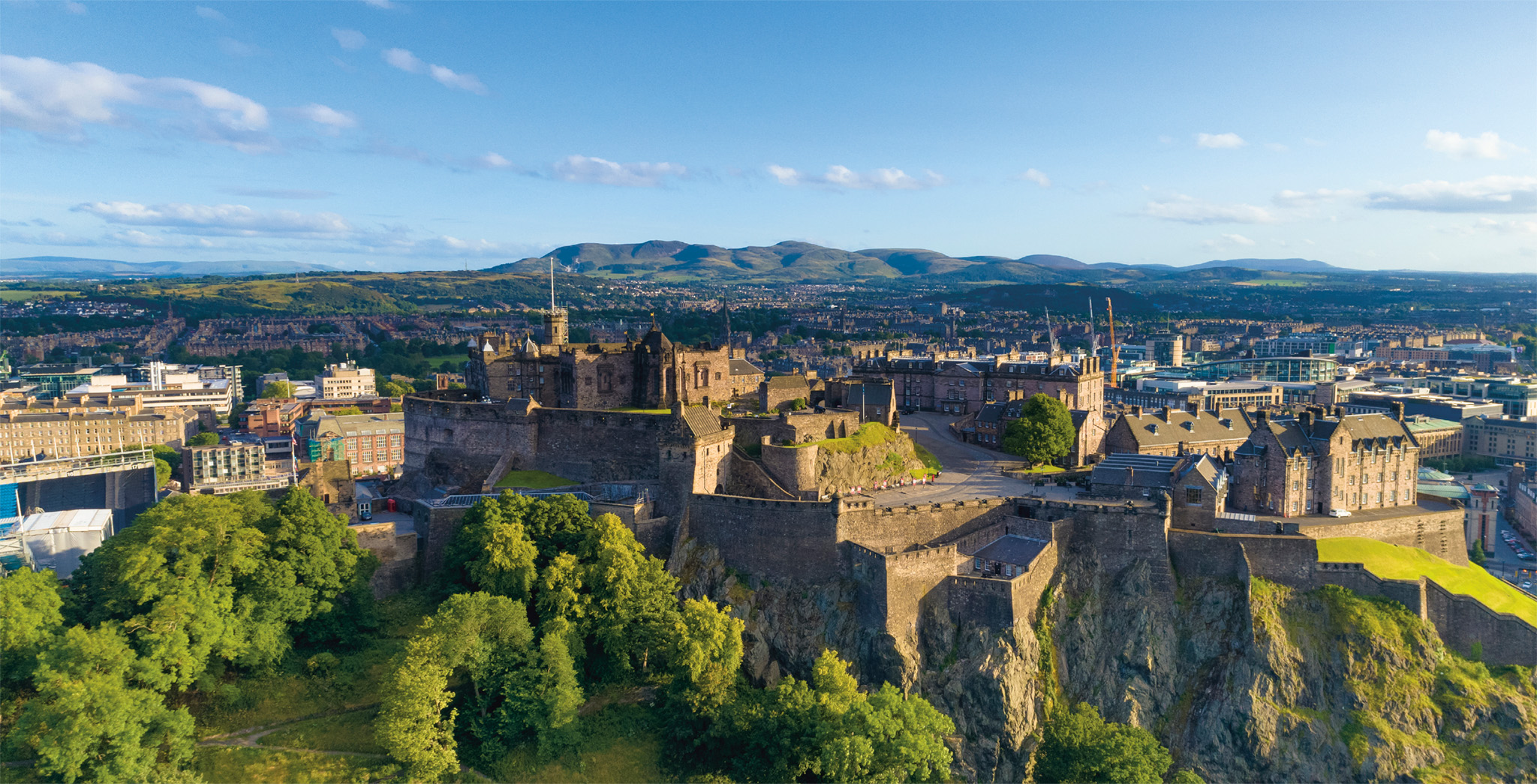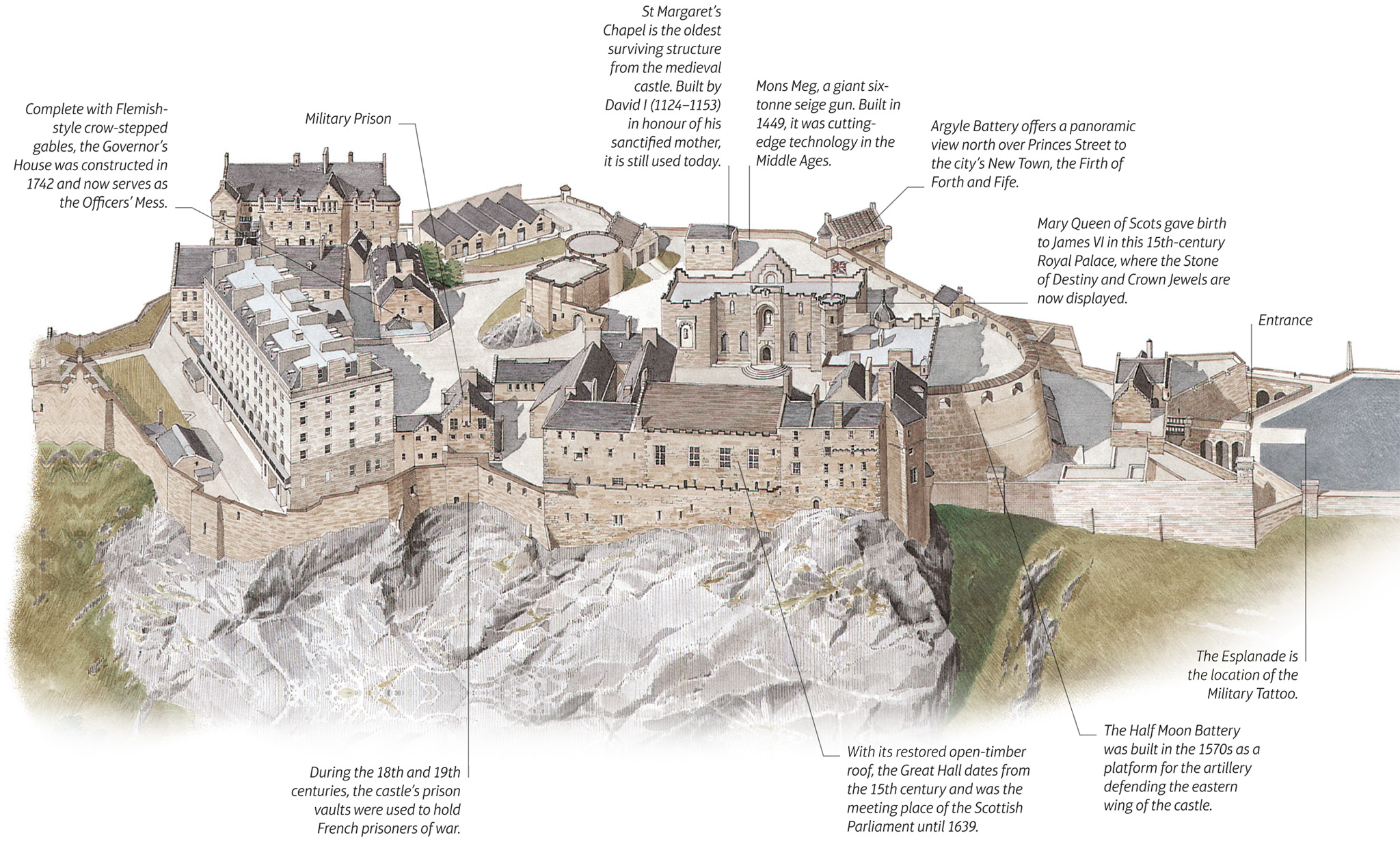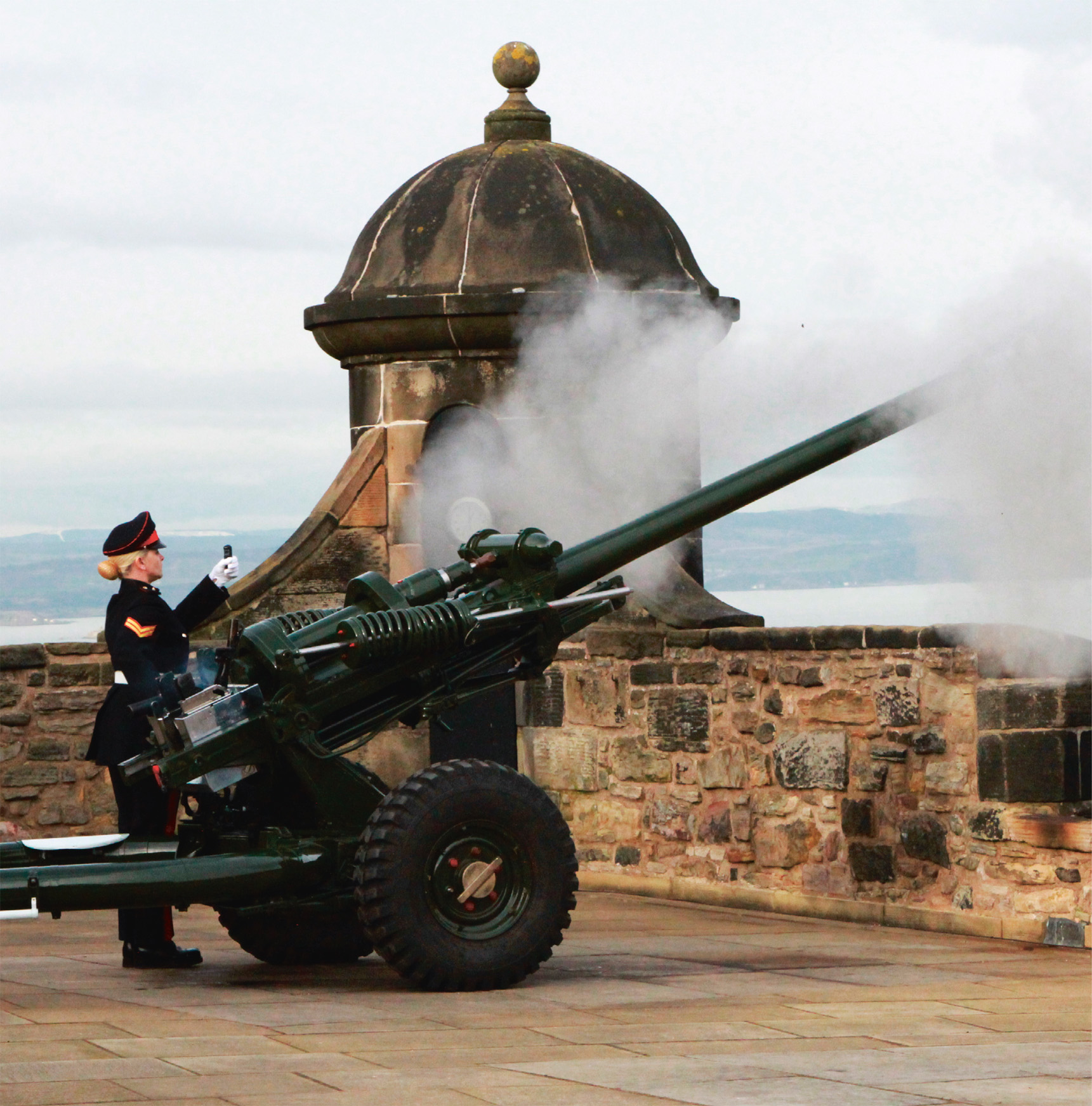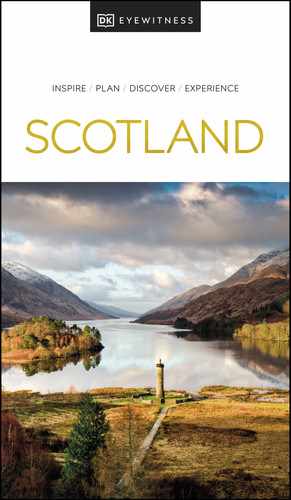A3 ⌂ Castlehill # 9:30am–6pm daily (Oct–Mar: to 5pm); last admission: 1 hour before closing ∑ edinburghcastle.scot
Dominating the city’s skyline since the 12th century, Edinburgh Castle is a national icon and is, deservedly, Scotland’s most popular visitor attraction.

t Edinburgh Castle dominates the city’s skyline
Experience Edinburgh

n Double-tap image to read the labels
t Illustration of Edinburgh Castle, an ancient fortress on top of Castle Rock
Standing upon the basalt core of an extinct volcano, Edinburgh Castle is an assemblage of buildings dating from the 12th to the 20th century, reflecting its changing role as fortress, royal palace, military garrison and state prison. Though there is evidence of Bronze Age occupation of the site, the original fortress was built by the 6th-century Northumbrian king, Edwin, from whom the city takes its name. The castle was a favourite royal residence until the Union of the Crowns in 1603, after which the king resided in England. After the Union of Parliaments in 1707, the Scottish regalia were walled up in the palace for over a hundred years. The palace is now the zealous possessor of the so-called Stone of Destiny, a relic of ancient Scottish kings which was seized by the English and not returned to Scotland until 1996.
Experience Edinburgh
The One O’clock Gun

Resounding across the city at 1pm Mon–Sat, Edinburgh’s One O’Clock Gun has been startling visitors since 1861. It was originally intended to help ships moored in the Firth of Forth to synchronize their chronometers to Greenwich Mean Time, essential for accurate navigation, but it has now become a time-honoured tradition. The first guns were muzzle-loading cannons, but since 2001 a more modern 105mm artillery piece has served.

Insider tip
Festival Fireworks
Every night during the Edinburgh Festival, the Castle hosts a fireworks display to mark the end of the Military Tattoo. Climb to the top of Calton Hill to watch this pyrotechnic spectacle for free.
Exploring The Castle
Standing guard over the city, Edinburgh Castle is always an impressive sight, but to best appreciate this fortress, explore the complex behind the imposing walls. From the entrance on the lower ward, over which looms the impressive Half Moon Battery, walk through the Middle Ward, with the Argyle Battery on the right and, a little further up, the famous One o’Clock Gun. Beyond the National War Museum is the Upper Ward, or Crown Square, location for the Great Hall and Royal Palace, the latter housing both the Stone of Destiny and Crown Jewels. Dominating the highest part of the complex is St Margaret’s Chapel, which stands close to the iconic Mons Meg siege gun.
The Esplanade and Lower Ward
Fronting the castle entrance, the Esplanade is essentially one vast coach park, but is also traditionally used as the venue for the Edinburgh Military Tattoo, the famous military display hosted at the castle. This heritage explains the many memorials to members of the armed forces dotted around here. Seek out the monument to Field Marshal Earl Haig, who was an important figure on the Western Front of World War I.
Moving on, walk through the entrance to the castle. Beyond the gatehouse, head up through the Lower Ward to the Middle Ward and the Argyle Battery, which affords terrific views of the city, and the booming One o’Clock Gun. Try to time your visit with its firing if you can.
National War Museum and Royal Scots Dragoon Guards Museum
Tucked away behind the Governor’s House, the superb National War Museum documents more than 400 years of Scottish military conflict, courtesy of dozens of cabinets packed with medals, uniforms and insignia, as well as paintings. One of the most curious exhibits is “Bob the Dog”, the taxidermized pet of the Scots Fusilier Guards, 1st Battalion, in 1853–60, who stands complete with a shiny silver medal on his collar.
The equally illuminating Royal Scots Dragoon Guards Museum is located in the neighbouring New Barracks building; here you will find all kinds of memorabilia relating to the only Scottish cavalry regiment in the regular British Army.
Crown Square
The historic heart of the castle complex is Crown Square, whose south side is taken up by the Great Hall, a building notable for its magnificent hammer-beam roof designed by James IV and which was formerly the setting for the Scottish Parliament. Adjacent to the Great Hall stands the Renaissance-style Royal Palace, which harbours both the Stone of Destiny and the Honours of Scotland, more commonly known as the Crown Jewels – the most prominent exhibit is a richly bejewelled crown worn by James V. While you’re still on the square, don’t miss the Hall of Honour, housing the elegant Scottish National War Memorial, designed by Sir Robert Lorimer.
Experience Edinburgh
Mons Meg

Positioned outside St Margaret’s Chapel, this six-tonne siege gun (or bombard) was made in Belgium in 1449 for the Duke of Burgundy, who gave it to his nephew, James II of Scotland. It was used by James against the Douglas family in their stronghold of Threave Castle in 1455, and later by James IV against Norham Castle in England. After exploding during a salute to the Duke of York in 1682, it was kept in the Tower of London until it was returned to Edinburgh in 1829.
EXPERIENCE Edinburgh
Timeline |

c 1130The first structure on Castle Rock is built by David I (c 1084–1153) |
1269Edinburgh Castle is captured by Edward I (1239–1307) |
1356David II (1324–71) rebuilds the castle |

1573Much of the castle is destroyed during the Lang Siege in the Civil War |

1650Oliver Cromwell besieges the castle for three months |
1745Bonnie Prince Charlie unsuccessfully tries to take the castle |
1757Edinburgh Castle turned into a prison |

1927A section of the castle is turned into the Scottish National War Memorial |
